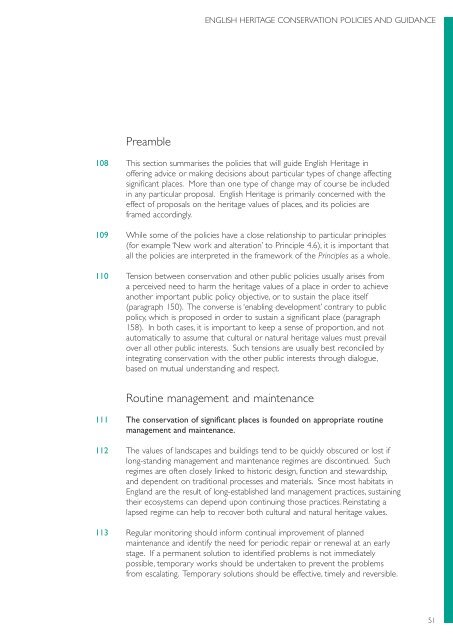Conservation Principles, Policies and Guidance - English Heritage
Conservation Principles, Policies and Guidance - English Heritage
Conservation Principles, Policies and Guidance - English Heritage
Create successful ePaper yourself
Turn your PDF publications into a flip-book with our unique Google optimized e-Paper software.
Preamble<br />
ENGLISH HERITAGE CONSERVATION POLICIES AND GUIDANCE<br />
108 This section summarises the policies that will guide <strong>English</strong> <strong>Heritage</strong> in<br />
offering advice or making decisions about particular types of change affecting<br />
significant places. More than one type of change may of course be included<br />
in any particular proposal. <strong>English</strong> <strong>Heritage</strong> is primarily concerned with the<br />
effect of proposals on the heritage values of places, <strong>and</strong> its policies are<br />
framed accordingly.<br />
109 While some of the policies have a close relationship to particular principles<br />
(for example ‘New work <strong>and</strong> alteration’ to Principle 4.6), it is important that<br />
all the policies are interpreted in the framework of the <strong>Principles</strong> as a whole.<br />
110 Tension between conservation <strong>and</strong> other public policies usually arises from<br />
a perceived need to harm the heritage values of a place in order to achieve<br />
another important public policy objective, or to sustain the place itself<br />
(paragraph 150). The converse is ‘enabling development’ contrary to public<br />
policy, which is proposed in order to sustain a significant place (paragraph<br />
158). In both cases, it is important to keep a sense of proportion, <strong>and</strong> not<br />
automatically to assume that cultural or natural heritage values must prevail<br />
over all other public interests. Such tensions are usually best reconciled by<br />
integrating conservation with the other public interests through dialogue,<br />
based on mutual underst<strong>and</strong>ing <strong>and</strong> respect.<br />
Routine management <strong>and</strong> maintenance<br />
111 The conservation of significant places is founded on appropriate routine<br />
management <strong>and</strong> maintenance.<br />
112 The values of l<strong>and</strong>scapes <strong>and</strong> buildings tend to be quickly obscured or lost if<br />
long-st<strong>and</strong>ing management <strong>and</strong> maintenance regimes are discontinued. Such<br />
regimes are often closely linked to historic design, function <strong>and</strong> stewardship,<br />
<strong>and</strong> dependent on traditional processes <strong>and</strong> materials. Since most habitats in<br />
Engl<strong>and</strong> are the result of long-established l<strong>and</strong> management practices, sustaining<br />
their ecosystems can depend upon continuing those practices. Reinstating a<br />
lapsed regime can help to recover both cultural <strong>and</strong> natural heritage values.<br />
113 Regular monitoring should inform continual improvement of planned<br />
maintenance <strong>and</strong> identify the need for periodic repair or renewal at an early<br />
stage. If a permanent solution to identified problems is not immediately<br />
possible, temporary works should be undertaken to prevent the problems<br />
from escalating. Temporary solutions should be effective, timely <strong>and</strong> reversible.<br />
51

















